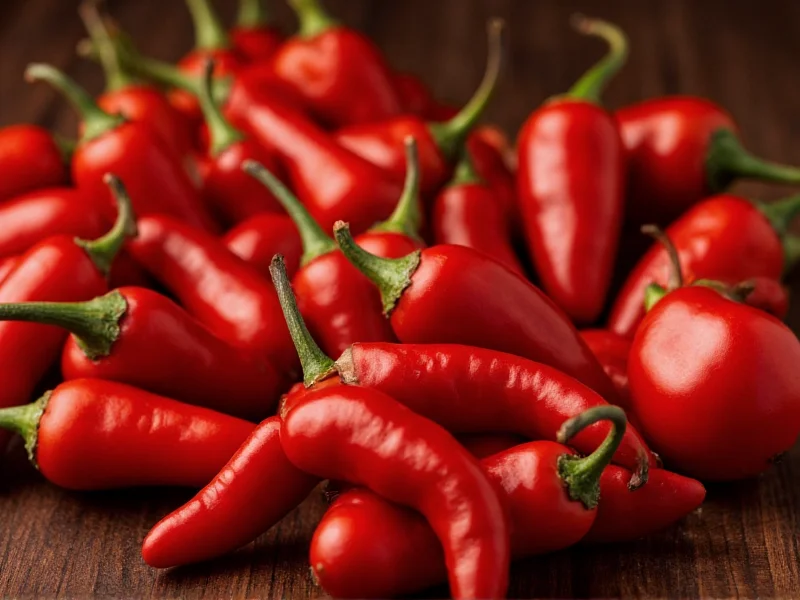Chipotle peppers aren't just hot—they offer a complex flavor experience that makes them a staple in many kitchens. Understanding their heat level helps you use them effectively in your cooking without overwhelming your palate.
What Exactly Is a Chipotle Pepper?
A chipotle pepper is simply a ripe jalapeño that's been smoke-dried. The name comes from the Náhuatl word "chilpoctli," meaning "smoked chili." This smoking process transforms the green jalapeño into a wrinkled, brownish-red pepper with a deep, smoky flavor that complements its inherent heat.
Chipotle Heat Level Explained
On the Scoville scale—which measures capsaicin concentration—chipotle peppers register between 2,500 and 8,000 SHU. This places them firmly in the medium-heat category. For context:
| Pepper Type | Scoville Heat Units | Heat Level |
|---|---|---|
| Chipotle Pepper | 2,500-8,000 | Medium |
| Regular Jalapeño | 2,500-8,000 | Medium |
| Serrano Pepper | 10,000-23,000 | Medium-Hot |
| Habanero Pepper | 100,000-350,000 | Very Hot |
Since chipotles are made from jalapeños, their heat range matches fresh jalapeños. However, the perception of heat can differ due to the smoking process and concentration of flavors in the dried form.
Factors That Affect Chipotle Pepper Heat
Several elements influence how hot your chipotle peppers might taste:
- Ripeness at harvest: Fully red jalapeños (used for chipotles) tend to be hotter than green ones
- Growing conditions: Soil quality, climate, and water stress affect capsaicin production
- Individual variation: Like all chilies, heat can vary significantly between peppers
- Preparation method: Seeds and membranes contain most capsaicin—removing these reduces heat
How Smoking Affects Heat Perception
The smoking process that creates chipotle peppers doesn't actually increase capsaicin levels. However, it does concentrate flavors as moisture is removed, which can make the heat feel more intense. Additionally, the smoky flavor creates a different sensory experience that some perceive as "hotter" even when the actual capsaicin content remains the same as fresh jalapeños.
Using Chipotle Peppers Based on Heat Tolerance
Understanding chipotle pepper heat helps you incorporate them appropriately:
- Mild heat preference: Use 1-2 chipotle peppers in adobo sauce per recipe serving 4-6 people, removing seeds and membranes
- Medium heat preference: Use 2-3 whole chipotles or 1-2 tablespoons of adobo sauce per recipe
- High heat tolerance: Add extra chipotle seeds or increase quantity gradually to taste
Remember that dried chipotle peppers are more concentrated than their fresh counterparts. When rehydrating dried chipotles, start with one pepper and adjust as needed—the heat will intensify as liquid reduces during cooking.
Chipotle in Adobo Sauce: A Common Form
Most home cooks encounter chipotles in adobo sauce—a tangy, tomato-based sauce that tempers the heat while adding complexity. The sauce itself contains vinegar, garlic, and spices that balance the pepper's spiciness. When using chipotles in adobo, remember that both the pepper and the sauce contribute heat to your dish.
Practical Tips for Handling Chipotle Heat
To manage chipotle pepper heat effectively:
- Always wear gloves when handling dried chipotles or seeds
- Start with less than you think you need—you can always add more heat but can't remove it
- Balance heat with dairy (yogurt, sour cream), acid (lime juice), or sweetness (honey)
- Remove seeds and white membranes for milder flavor
- Soak dried chipotles in warm water or broth to rehydrate before use
Common Misconceptions About Chipotle Heat
Several myths persist about chipotle peppers:
- Myth: Chipotles are significantly hotter than fresh jalapeños Fact: They share the same heat range since they're made from jalapeños
- Myth: The smoking process increases heat Fact: Smoking concentrates flavors but doesn't increase capsaicin
- Myth: All chipotles have consistent heat levels Fact: Significant variation exists between batches and brands
Conclusion
Chipotle peppers deliver reliable medium heat (2,500-8,000 SHU) with the added dimension of smokiness that makes them versatile in cooking. Whether you're making barbecue sauce, mole, or adding depth to soups and stews, understanding their heat profile helps you use them effectively. Remember that individual tolerance varies, so always start conservatively and adjust to your preference. The beauty of chipotle peppers lies in their ability to provide noticeable heat while contributing complex flavor that enhances rather than overwhelms your dishes.
Frequently Asked Questions
Are chipotle peppers hotter than regular jalapeños?
No, chipotle peppers are not hotter than regular jalapeños—they are actually the same pepper. Chipotles are simply smoke-dried jalapeños, so they share the same heat range of 2,500-8,000 Scoville units. The perception of heat might differ slightly due to flavor concentration from drying, but the actual capsaicin content remains comparable.
How does chipotle pepper heat compare to other common peppers?
Chipotle peppers (2,500-8,000 SHU) are milder than serrano peppers (10,000-23,000 SHU) and significantly milder than habaneros (100,000-350,000 SHU). They share the same heat range as fresh jalapeños but offer a smoky dimension that changes the heat perception. Compared to bell peppers (0 SHU) or poblanos (1,000-2,000 SHU), chipotles are noticeably hotter.
Does the adobo sauce affect chipotle pepper heat?
Yes, the adobo sauce in which chipotles are often packed contains vinegar, garlic, and spices that balance and moderate the heat. The sauce itself becomes infused with capsaicin, so both the peppers and the surrounding liquid contribute to the overall heat level. When using chipotles in adobo, remember that the sauce adds additional heat beyond just the peppers themselves.
How can I reduce the heat of chipotle peppers in my recipe?
To reduce chipotle pepper heat, remove the seeds and white membranes (where most capsaicin concentrates), use fewer peppers, or balance with dairy products like yogurt or sour cream. You can also dilute the heat by adding more of the other recipe ingredients, incorporating sweetness (honey or sugar), or adding acid (lime juice or vinegar) which helps counteract spiciness without eliminating the smoky flavor.











 浙公网安备
33010002000092号
浙公网安备
33010002000092号 浙B2-20120091-4
浙B2-20120091-4